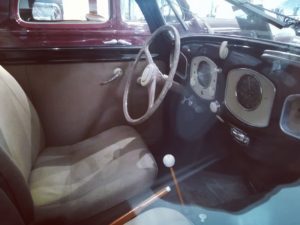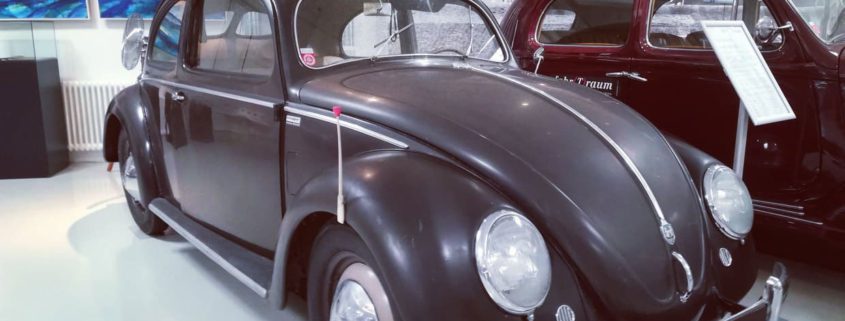NEW unrestored 1952 Pretzel Beetle at fahr(T)raum
The Ferdinand Porsche Worlds of Experience fahr(T)raum has been enhanced by a special exhibit: a 1952 25 hp VW Pretzel Beetle in its original state; a rarity among collectors nowadays.
The nickname “pretzel beetle” is derived from the design of the rear window which, with its two semi-oval panes divided by a central bar, is reminiscent of the shape of a pretzel. The split window was not a design decision, but simply a financial consideration: a convex window pane that would have integrated into the curved rear would have been too expensive for the moderately-priced small car.
In 1934, Ferdinand Porsche was commissioned by the Reich Association of the German Automobile Industry to develop a fuel-efficient and economical car – a “Volkswagen”, later known as the “KdF-Wagen” (Strength through Joy car). In 1938, some pre-production cars were shown at exhibitions, but not yet delivered to customers. The specially built Volkswagen factory was only finished during the war.
 After the war ended in 1945 – the Volkswagen factory now in the British hands – the first mass-produced Volkswagen Type 1 were initially delivered only to the United Kingdom and the United States occupying forces and to the Deutsche Post. Production for the civilian population took place from 1948. Technically, the Beetle corresponded to the previous models: central tube frame with base plate made of sheet steel, torsion bar suspension, air-cooled four-cylinder boxer engine, top speed 100 km/h, curb weight 750 kg. Export to the USA after 1950 was a great success and the nickname “beetle” or “bug” came into fashion. In Germany, the term “Beetle” prevailed only from 1961 – in contrast to the VW 1500 notchback model (internally called Type 3).
After the war ended in 1945 – the Volkswagen factory now in the British hands – the first mass-produced Volkswagen Type 1 were initially delivered only to the United Kingdom and the United States occupying forces and to the Deutsche Post. Production for the civilian population took place from 1948. Technically, the Beetle corresponded to the previous models: central tube frame with base plate made of sheet steel, torsion bar suspension, air-cooled four-cylinder boxer engine, top speed 100 km/h, curb weight 750 kg. Export to the USA after 1950 was a great success and the nickname “beetle” or “bug” came into fashion. In Germany, the term “Beetle” prevailed only from 1961 – in contrast to the VW 1500 notchback model (internally called Type 3).
In 1953, the split rear window of the pretzel beetle was replaced by a one-piece oval window made of slightly curved safety glass 23% larger than the two small panes. 1957 saw a larger rectangular rear window. One could also acquire the single rear window for installation in older models.
Nowadays, for nostalgic reasons, the divided rear windows are often fitted – using conversion kits that allow the previously cut-out central bar to be re-welded.
A total of 21,529,464 VW Beetles were produced until production ceased on July 30, 2003.
At fahr(T)raum one can now admire an unrestored Pretzel Beetle in its original condition from 1952. From 5 October 2019, a special exhibition on Beetle convertibles will also open. One of the first pretzel convertibles, meticulously and faithfully restored by Alexander Fritz, is the heart piece of the exhibition. Further information at: A beetle convertible | Special Exhibition
Quellen
https://de.wikipedia.org/wiki/Brezelk%C3%A4fer
https://de.wikipedia.org/wiki/VW_K%C3%A4fer
https://de.wikipedia.org/wiki/KdF-Wagen
http://www.vw-kaeferclub-kaernten.at/wp-content/uploads/2018/04/VW_Clubzeitung.pdf
Bilder, © fahr(T)raum
You might also be interested in:







Austro Daimler Alpenwagen Year of manufacture 1911 now at fahr(T)raum
/in Geschichte, News, RennautosThe last surviving AD 9/27 Alpenwagen stands in Mattsee The Ferdinand Porsche Erlebniswelten fahr(T)raum Mattsee/Salzburg is currently displaying an AD 9/27 HP Alpenwagen. This sports car – a successful further development of the AD 20 HP – is the only surviving car of this type; one other was destroyed in a fire. In the autumn […]
Ferdinand Porsche at Daimler (Mercedes)-Benz
/in Geschichte, Lebensstationen, News, Rennautos1926 Mercedes 24/100/140 PS on display in fahr(T)raum Ferdinand Porsche left Austro Daimler in 1923 due to differences with the Supervisory Board. As of April 30, 1923, he succeeded Paul Daimler on the Board of Management and as Chief Designer at the Daimler-Motoren-Gesellschaft (DMG) in Stuttgart. At Daimler he was in charge of the further […]
“King of the Mountains” Hans Stuck and his Austro Daimler racing cars
/in Geschichte, News, Rennautos, Sonstige FahrzeugeA ADM-R racing car and a ADM-R “Torpedo” (1929) now in fahr(T)raum Anyone scrutinising the history of European automobile racing sport in the last century will have encountered his name: Hans Stuck (1900-1978). The Bavarian started his career rather modestly as a milk delivery man where, as legend would have it, his driving style turned […]